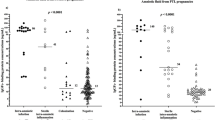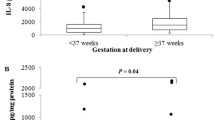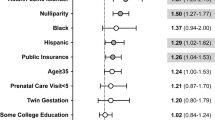Abstract
Objective:
The aim of this study was to evaluate the usefulness of maternal serum and vaginal fluid C-reactive protein (CRP) determinations in the prediction of neonatal congenital infection.
Study Design:
Fifty women between 24 and 36 weeks gestation, complicated by preterm premature rupture of membranes (pPROM), were divided into two groups according to the presence (n=14) or absence (n=36) of early-onset newborns' infection.
Result:
Maternal serum and vaginal fluid CRP concentrations were comparable between both groups. Serum CRP levels ⩾10 and ⩾15 mg l–1 predicted neonatal infection with a sensitivity of 47 and 47%, specificity of 63 and 76%, positive predictive value (PPV) of 38 and 47%, and negative predictive value (NPV) of 72 and 76%, respectively. The cutoff value of vaginal CRP ⩾2.4 mg l–1 predicted infection with a sensitivity of 71%, specificity of 47%, PPV of 34%, and NPV of 81%. Receiver-operating characteristic curve analysis revealed that the predictive performance of CRP was poor.
Conclusion:
Maternal serum and vaginal fluid CRP determinations after pPROM are of poor predictive value in neonatal early-onset infection prediction.
This is a preview of subscription content, access via your institution
Access options
Subscribe to this journal
Receive 12 print issues and online access
$259.00 per year
only $21.58 per issue
Buy this article
- Purchase on Springer Link
- Instant access to full article PDF
Prices may be subject to local taxes which are calculated during checkout


Similar content being viewed by others
References
Fortunato SJ, Menon R, Lombardi SJ . Role of tumor necrosis factor alpha in the premature rupture of membranes and preterm labor pathways. Am J Obstet Gynecol 2002; 187: 1159–1162.
Kayem G, Goffinet F, Batteux F, Jarreau PH, Weill B, Cabrol D . Detection of interleukin-6 in vaginal secretions of women with preterm premature rupture of membranes and its association with neonatal infection: a rapid immunochromatographic test. Am J Obstet Gynecol 2005; 192: 140–145.
Shim SS, Romero R, Jun JK, Moon KC, Kim G, Yoon BH . C-reactive protein concentration in vaginal fluid as a marker for intraamniotic inflammation/infection in preterm premature rupture of membranes. J Matern Fetal Neonatal Med 2005; 18: 417–422.
Mishra UK, Jacobs SE, Doyle LW, Garland SM . Newer approaches to the diagnosis of early onset neonatal sepsis. Arch Dis Child Fetal Neonatal Ed 2006; 91: F208–F212.
Ghidini A, Salafia CM, Kirn W, Doria V, Spong CY . Biophysical profile in predicting acute ascending infection in preterm rupture of membranes before 32 weeks. Obstet Gynecol 2000; 96: 201–206.
Hatzidaki E, Gourgiotis D, Manoura A, Korakaki E, Bossios A, Galanakis E et al. Interleukin-6 in preterm premature rupture of membranes as an indicator of neonatal outcome. Acta Obstet Gynecol Scand 2005; 84: 632–638.
Levis DF, Barrilleaux PS, Wang Y, Adair CD, Baier J, Kruger T . Detection of interleukin-6 in maternal plasma predicts neonatal and infectious complications in preterm premature rupture of membranes. Am J Perinatol 2001; 18: 387–391.
Martius JA, Roos T, Gora B, Oehler MK, Schrod L, Papadopoulos T et al. Risk factors associated with early-onset sepsis in premature infants. Eur J Obstet Gynecol Reprod Biol 1999; 85: 151–158.
Park KH, Yoon BH, Shim SS, Jun JK . Amniotic fluid tumor necrosis factor alpha is a marker for the prediction of early-onset neonatal sepsis in preterm labor. Gynecol Obstet Invest 2004; 58: 84–90.
Di Naro E, Ghezzi F, Raio L . C-reactive protein in vaginal fluid of patients with preterm premature rupture of membranes. Acta Obstet Gynecol Scand 2003; 82: 1072–1079.
Torbé A, Czajka R . Are vaginal fluid procalcitonin levels useful for the prediction of subclinial infection in patients with preterm premature rupture of membranes? J Obstet Gynec Res 2005; 31: 464–470.
Yoon BH, Romero R, Shim JY, Shim SS, Kim CJ, Jun JK . C-reactive protein in umbilical cord blood: a simple and widely available method to assess the risk of amniotic fluid infection and funisitis. J Matern Fetal Neonatal Med 2003; 14: 85–90.
Chen FC, Sarioglu N, Bûscher U, Dudenhausen JW . Lipopolysaccharide binding protein in the early diagnosis of intraamniotic infection of pregnant women with premature rupture of the membranes. J Perinat Med 2009; 37: 135–139.
He JP . C-reactive protein and acute-phase proteins in monitoring infection caused by premature rupture of membranes. Zhonghua Fu Chan Ke Za Zhi 1990; 25: 98–101.
Kurki T, Teramo K, Ylikorkala O, Paavonen J . C-reactive protein in preterm premature rupture of the membranes. Arch Gynecol Obstet 1990; 217: 31–37.
Saini S, Goel N, Sharma M, Arora B, Garg N . C-reactive proteins as an indicator of sub-clinical infection in cases of premature rupture of membranes. Indian J Phatol Microbiol 2003; 46: 515–516.
krablin S, Lovric H, Banovic V, Kralik S, Dijakovic A, Kalafatic D . Maternal plasma interleukin-6, interleukin-1beta and C-reactive protein as indicators of tocolysis failure and neonatal outcome after preterm delivery. J Matern Fetal Neonatal Med 2007; 20: 335–341.
Yoon BH, Yang SH, Jun JK, Park KH, Kim CJ, Romero R . An elevated C-reactive protein, WBC, or AF WBC identified patients with intrauterine infection and adverse perinatal outcomes. Obstet Gynecol 1996; 87: 231–237.
Trochez-Martinez RD, Smith P, Lamont RF . Use of C-reactive protein as a predictor of chorioamnionitis in preterm prelabour rupture of membranes: a systematic review. BJOG: Int J Obstet Gynecol 2007; 114: 796–801.
Wiwanitkit V . Maternal C-reactive protein for the detection of chorioamnionitis: an appraisal. Infect Dis Obstet Gynecol 2005; 13: 179–181.
Gibbs RS, Romero R, Hillier SL, Eschenbach DA, Sweet RL . A review of premature birth and subclinical infection. Am J Obstet Gynecol 1992; 16: 1515–1528.
Bańkowska E, Leibschang J, Pawlowska A . Usefulness of determination of granulocyte elastase plasma level, C-reactive protein and white blood cell count in prediction of intrauterine infection in pregnant women after PPROM. Ginekol Pol 2003; 74: 1037–1043.
Baud O, Emilie D, Pelletier E, Lacaze-Masmonteil T, Zupan V, Fernandez H et al. Amniotic fluid concentrations of interleukin-1beta, interleukin-6 and TNF-alpha in chorioamnionitis before 32 weeks of gestation: histological associations and neonatal outcome. Br J Obstet Gynaecol 1999; 106: 72–77.
Levy MM, Fink MP, Marshall JC, Abraham E, Angus D, Cook D et al. 2001 SCCM/ESICM/ACCP/ATS/SIS International Sepsis Definitions Conference. Crit Care Med 2003; 31: 1250–1256.
Goldstein B, Giroir B, Randolph A . Members of the International Consensus on Pediatric Sepsis. International Pediatric Sepsis Consensus Conference: definitions for sepsis and organ dysfunction in pediatrics. Pediatr Crit Care Med 2005; 6: 2–8.
Hillier SL, Witkin SS, Krohn MA, Watts DH, Kiviat NB, Eschenbach DA . The relationship of amniotic fluid cytokines and preterm delivery, amniotic fluid infection, histologic chorioamnionitis and chorioamnion infection. Obstet Gynecol 1993; 81: 941–948.
Torbé A . Evaluation of cytokines and procalcitonin concentrations in cervico-vaginal secretion, in plasma blood and in amniotic fluid in pregnancy complicated by preterm labor. Habilitation thesis. Ann Acad Med Stetin 2003; Supl 92.
Author information
Authors and Affiliations
Corresponding author
Ethics declarations
Competing interests
The authors declare no conflict of interest.
Rights and permissions
About this article
Cite this article
Torbé, A., Kowalski, K. Maternal serum and vaginal fluid C-reactive protein levels do not predict early-onset neonatal infection in preterm premature rupture of membranes. J Perinatol 30, 655–659 (2010). https://doi.org/10.1038/jp.2010.22
Received:
Revised:
Accepted:
Published:
Issue Date:
DOI: https://doi.org/10.1038/jp.2010.22



